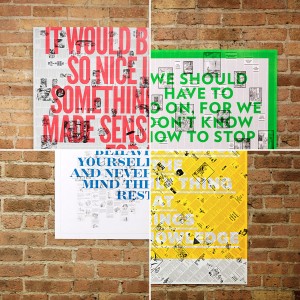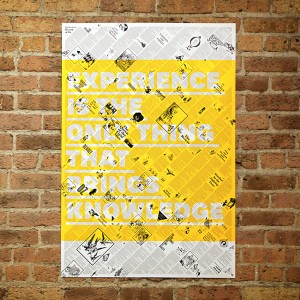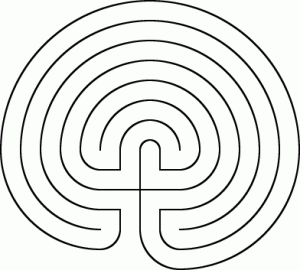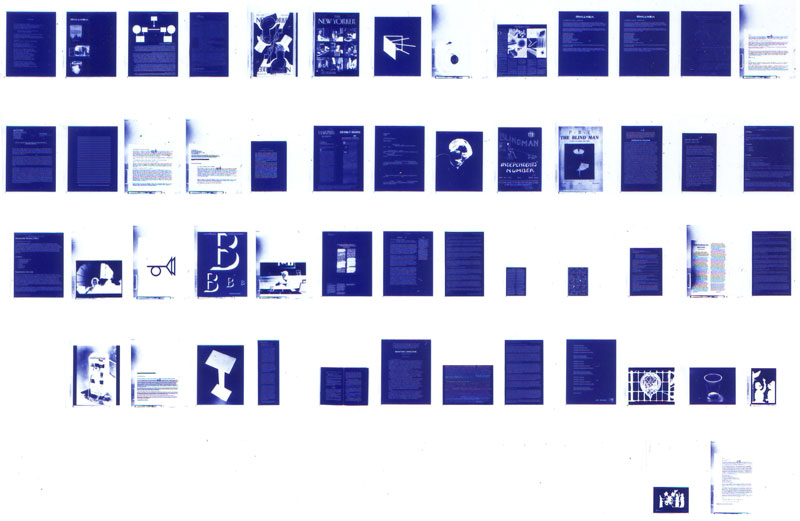
Dexter Sinister's "A skeleton, a script, or a good idea in advance of its realization," 2010. Risograph print with multiple passes, edition of 100. Image: Triple Canopy, Brooklyn.
Lines are incredibly important in the construction of narrative. Actually, like in drawing and painting, lines figure very early in the storytelling process with the letter, as in the alphabetic kind, the sign that signifies the sound. A letter is a line that has curved back on itself to form the literality of the letter, making it a sign that has meaning because it can be distinguished from other signs. Becoming even more complex as the story grows, lines as literal figures organize and structure the narrative in a figurative sense. Linear narrative—a story that progresses only forward in time and space like in a straight line—is perhaps the most easily recognized narrative figure. Other figures of linear origins are common as well, such as circular narrative, in which the beginning and end meet, or the web narrative, which forms through multiple linear narratives running and intersecting. One narrative that is less common, especially in American-born tales, but is present in some of the most groundbreaking works of art and literature, is the labyrinthine narrative.

Design duo BB÷KK cleverly manipulate lines, letters and narrative structure in their recent poster series featuring "Alice's Adventures in Wonderland," "Peter and Wendy," "The Wonderful Wizard of Oz" and "Peter Rabbit," 2011. This poster series actually centers on two of the very few instances of labyrinths found in American fiction, the underground world traveled by Alice in "Alice's Adventures in Wonderland" and the yellow brick road Dorothy walks in "The Wonderful Wizard of Oz." Both images courtesy BB÷KK: https://bbkk.bigcartel.com.
In its current definition, labyrinth has come to mean several things at once. In everyday speech it operates metaphorically as a complex or difficult, overall confusing situation. As an allegory labyrinth is used loosely, becoming synonymous with spiral, meander, concentric circles and, most often, maze, which is defined as a tortuous structure consisting of two openings—an entrance and an exit—and multiple pathways, some of which lead to forks, blind alleys and dead ends. For the purpose of this essay, however, I use the word labyrinth to refer to its original figure, which Hermann Kern aptly describes in Through the Labyrinth:
The perimeter may take a round, a rectangular, or a polygonal form, which usually determines the shape of the circuits inside. The layout of the labyrinth’s path is largely unaffected by differences in shape. What is important is that the outer line clearly separates the exterior from the interior space. The perimeter has only one opening… the entrance. Just beyond [it] the wanderer is led down a winding but unicursal path that inevitably ends at the center.
The labyrinth can assume a number of forms, but remains a labyrinth only if the path is not intersected. Ancient Crete holds the earliest record of the labyrinth, which presents itself at once as a narrative structure, visual motif and literal form. One of Daedalus’ many ingenious works, the first documented labyrinth housed the Knossos Minotaur. When hero Theseus goes in to kill the Minotaur, he follows the curving line of the labyrinth’s path, sure that he will meet the half-bull, half-human head on because there is only one direction in which he may proceed.
The labyrinth soon thereafter shows up around the world (except in the United States’ native American and European settler cultures), likely thought to be a metaphor for human discovery, thought, memory and experience because of its pendular swing between past and present. Acclaimed Argentine fiction writer Jorge Luis Borges was fascinated with this aspect of the labyrinth. His stories like “The House of Asterion” deal directly with the ancient Cretan labyrinth, while those similar to “Death and the Compass” dually employ the labyrinth as a narrative format and device for mocking pulp-fiction mysteries. But Borges’ most accomplished works consider the labyrinth in every which way of being, and the incredible meta-text, “The Library of Babel” presents it infinitely. This short story turns on the narrator’s and the librarians’ attempts to make sense of the infinite building in which they find themselves, a building that has been neatly divided into hexagonal rooms that open on to one another while surrounding a grand central staircase. This incalculable space, a library of the grandest proportions, houses so many books that the narrator explains that it contains all possible books; that is, its shelves hold all the infinite variations without duplication of every book whose pages could be generated by random lines of letters, words, or phrases. Yet each book sends its reader back to reference yet another book, and that book sends him to another, imitating the pendular swing of the labyrinth and indicating the labyrinth as the ultimate allegory of the pursuit of knowledge. Through Borges we find that if the reader learns everything, he reaches the center of meaning, and there he meets death because the activity of accumulating knowledge is all that life is.

"The Curse of Bigness," 2010. Exhibition catalog designed by Dexter Sinister for Queens Museum of Art exhibition by the same title.
Artists engaged in processes of collecting, collating and distributing information often recreate the pendular swing of the labyrinth. Kurt Schwitters certainly built up a labyrinth around him in his studio using collected papers and objects, and Rodney Graham’s Vexation Island and Coruscating Cinnamon Granules allude to the loneliness inherent in labyrinthine structure. However, it’s projects by the likes of Dexter Sinister, the two-man design and publishing collaborative, whose process and projected narrative in such works as True Mirror and the consequent True Mirror Microfiche, True Mirror Microfiche Post-Script, True Mirror Post-Post-script and so forth rely on the labyrinth as a conceptual structure in the same way that the most complex literature does. These True Mirror projects begin with a composite of excerpts from writings and artworks derived from a variety of artists and authors, operating much like Borges’ library, where each text cannot fully communicate without referencing another, creating a spiraling line or path towards some ultimate meaning or understanding. Though Dexter Sinister says mirroring is the appropriate analogy to describe the project’s motion, I suggest instead that the back and forth between past and present, before and after, reference and creation always progresses forward toward a goal—a new piece of artwork. Or, if considered strictly in terms of the labyrinth, the True Mirror projects continue and lengthen the labyrinth, constantly regenerating the center. Just like Borges, Dexter Sinister, through their work’s perpetual and exponential qualities, pursue and accumulate knowledge; they live life fully. Once a true and final center is located, the project, like the narrator in “The Library of Babel,” will die.
*Because one must give credit where credit is due, “Painting with Words, Writing with Pictures” originates as the title of literary critic Franco Ricci’s brilliant book exploring visual description and perception in Italo Calvino’s stories.








